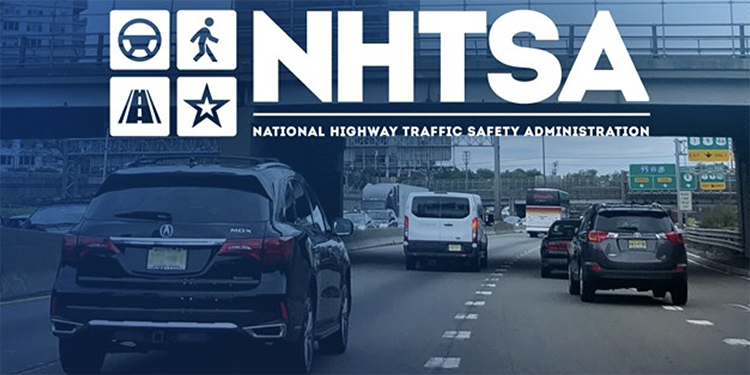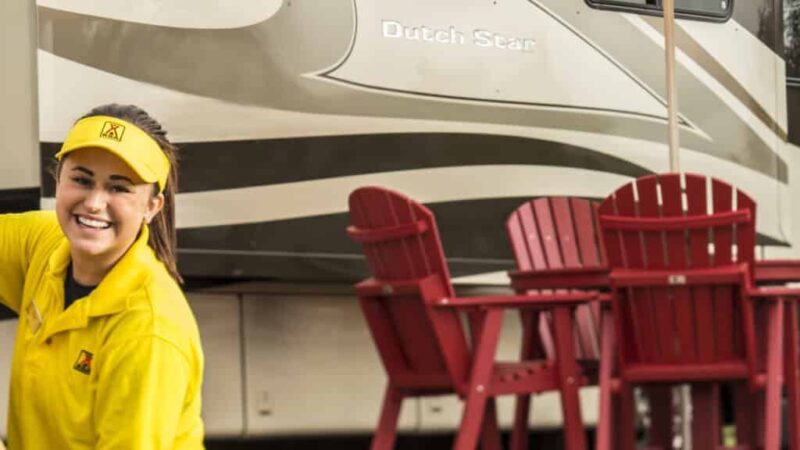RV Fire Safety
Being prepared for an RV fire, and armed with the right tools and knowledge, could save your vehicle and your life.
By Mark Quasius, F333630
December 2023
Man’s quest for fire dates to the beginning of time, and fire can be a good thing. It can be used to cook food, heat a living space, or add a bit of ambience. However, fire presents a risk that RVers need to keep top of mind. A fire can spread in a fast and furious manner, leading to devastating damage, injury, and even loss of life.
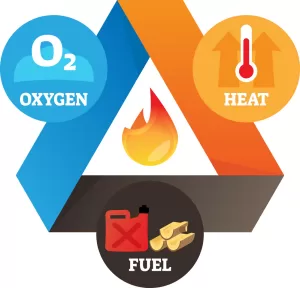
Oxygen, heat, and fuel are the three elements that must be present to support combustion. Eliminate one to extinguish a fire.
An RV has many potential sources where fires can break out. These can include RV refrigerators, propane appliances, gasoline or diesel engines, electrical wiring that takes a beating when traveling on less-than-ideal highways, etc. Thus, it’s important for every RV owner to develop a safety plan that covers how to deal with a fire. This involves fire extinguishers, as well as the necessary detection devices and an escape plan.
YOUR FIRST DECISION
If a fire breaks out, you’ll be faced with an important and immediate decision: fight or flight. It may be possible to handle a small fire with an extinguisher, but if the fire is larger, or if the fire prevents you from accessing an extinguisher, it’s time to exit the RV. Getting to the entry door is the ideal choice, but if it’s blocked by the fire, you’ll have to use an emergency exit window. But that’s not always as simple as it sounds. Getting to them — and getting through them — can be a challenge. Most are hinged to swing out, but some can swing shut on you, so you’ll need something handy to prop the window open while you climb out. This is something you may want to practice, because you won’t have time to figure it out during an actual fire.
Most exit windows are quite high off the ground, so the fall or drop can be significant. Some people move a picnic table next to the emergency window to lessen the distance. It’s best to go through the window feet first and belly down. Rope ladders are another option, but they require practice to learn how to use them and time to deploy them. Some Type A motorhomes even offer optional emergency egress doors. Smoke and heat accumulate fast during a fire, so it’s important to have an escape plan in place and practice so it becomes second nature when you really need it.
FIRE BASICS
A fire is really nothing more than a rapid chemical reaction. In order to begin, or sustain, this reaction, three key elements must be present: fuel, oxygen, and heat. This is sometimes referred to as the fire triangle. To extinguish a fire, you must eliminate at least one of these elements.
RVs contain an overabundance of fuel sources. They are made with large amounts of wood and composite materials that incorporate extensive amounts of glues and insulating foams. They also include plenty of wiring, with flammable insulation. In addition, most RVs have propane on board and — in the case of motorhomes — gasoline or diesel fuel. There’s always plenty of oxygen around, so all you need to complete the fire triangle is heat.
Materials that serve as fuel need to be raised only to their combustible temperature for ignition to occur. An electrical short can create intense heat in the wire, which can burn insulation or ignite surrounding materials such as wood paneling or foam insulation. A loose connection can also throw sparks that ignite fuels. Gases or flammable liquids that reach open flames or hot surfaces can flash and ignite.
 FIRE CLASSIFICATIONS
FIRE CLASSIFICATIONS
RVs are required to be equipped with a fire extinguisher, per National Fire Protection Association code. However, it only needs to meet the minimum requirements. So, fire extinguishers that come with RVs tend to be undersized and may not be equal to the task. Various classes of fires exist, and not all extinguishers are rated for every classification. So, let’s first discuss the most pertinent for RVers to know:
Class A fires use solid combustible fuels (other than metals). Examples are wood, paper, cloth, and plastics. Class A fires leave ash, so think of the word “Ash” to help remember the characteristics of this type of fire. To extinguish a Class A fire, you can either separate it from oxygen or cool it below its flash point. This is the easiest fire to extinguish, and water works well, because it cools the material below its combustible temperature. Ideally, an element is added to the water to help break the surface tension (soap works well) and separate the fuel from its oxygen, allowing the water to further cool down the fuel and suffocate it.
Class B fires originate from flammable liquids such as gasoline, oil, grease, diesel fuel, and alcohol. Liquids boil, so think of the word “Boil” to remember what Class B fires are. These fires can’t be extinguished with water, because the liquid fuel floats on the surface of the water and spreads to other areas, which only makes the situation worse.
Class C fires are electrical fires caused by energized circuits. If the circuit is live, consider it a Class C fire. Note that the wire itself doesn’t burn, but the insulation and things surrounding it do. Electrical wires conduct current, so associate the word “Current” with a Class C fire. The Class C designation only describes energized circuits, where water-type extinguishers could create an electrical shock hazard. Once the circuit is de-energized, you can treat it as a Class A fire.
FIRE EXTINGUISHER RATINGS
Fire extinguishers are rated by an alphanumeric rating system. The letter stands for the fire classification(s) that the extinguisher is rated to handle, while the number in front of the letter indicates the size fire it is designed to handle. The number preceding the letter “A” is a water equivalency rating, with each A equal to the effectiveness of using 1¼ gallons of water. For example, an extinguisher with a “2A” label is rated as effective as 2½ gallons of water on Class A fires.
The numerical designations for Class B and Class C extinguishers represent the square footage the extinguisher is designed to handle. For example, an extinguisher with a “10B:C” label is an extinguisher designed to handle Class B or C fires up to 10 square feet in size. It’s common to combine labels, such as “2A:10B:C,” on a single extinguisher. Obviously, the larger the number, the better equipped you’ll be to handle larger fires. Bigger is better, and you don’t want to run out of fire retardant before the fire is extinguished. The only drawback is the size of the larger extinguishers.
FIRE EXTINGUISHER TYPES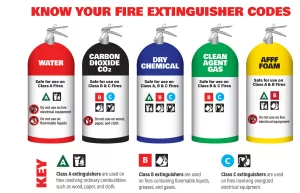
Air Pressurized Water (APW): APWs are large tanks filled about 2/3 with water and pressurized with compressed air. When the trigger is pulled, the water exits the hose and nozzle like a giant squirt gun. APWs are used to extinguish Class A fires by taking away the heat. They are not to be used on Class B fires, where the water would spread the burning liquid and create a larger fire. They also cannot be used on electrical circuits unless the power source has been removed. If the power is still on, the water can create an electrical shock hazard.
Carbon Dioxide CO2: CO2 extinguishers are filled with highly compressed CO2 gas. The extinguishers have a hard plastic horn rather than a hose and nozzle, and as the CO2 exits, it sprays what is essentially dry ice (the frozen form of CO2) on the flame. They operate by displacing oxygen from the fire, suffocating the flame. A side benefit is that the CO2 is cold, so it also helps cool the fire. CO2 extinguishers are rated for use on Class B and C fires and generally are not effective on Class A fires, because they may scatter burning particles and may not displace enough oxygen to smother the fire and prevent it from reigniting.
Dry Chemical: These are the most popular fire extinguishers available for consumer use today. The dry chemical, which resembles baking soda, is a fine powder that fills the extinguisher and is pressurized with nitrogen. The biggest reason for these extinguishers’ popularity is that you can use them on Class A, B, and C fires. They function by coating the fuel with a fine layer of chemical to separate the fuel from the oxygen. They also do not conduct electricity, so they are safe to use on electrical fires.
However, dry chemical extinguishers do have their drawbacks. First, these units are generally undersized. The small 5-pound extinguishers rated at 1A:10B:C typically found in an RV don’t have very much volume and should be replaced with a larger 10-pound unit rated at 3A:40B:C. Also, dry chemical leaves a real mess. The powder safely puts out electrical fires, but the chemical is toxic once heated and corrosive to electrical circuits. So, once the extinguisher is used, you’ll need to replace many of your electrical components. Dry chemical extinguishers are of minimal benefit on Class A fires, and most RVs are filled with the combustible materials that make up that classification.
Even though dry chemical extinguishers contain nitrogen, the dry chemical will settle and pack together over time. A good recommendation is to turn the extinguisher upside down and whack the base with a rubber mallet every six months to keep the powder loose enough to be able to be expelled when needed. These extinguishers also need to be regularly checked for any pressure leaks and require servicing, although many are inexpensive throwaways that are not serviceable and should be replaced.
Clean Agent Gas: These extinguishers are rated for Class B and C fires. They previously used an inert gas called halon to displace oxygen and smother the fire. Those earlier models have been banned in many areas because of atmospheric ozone depletion and have been replaced by extinguishers that contain other, safer gases. These are referred to as “clean agent gas” extinguishers. Unlike halon, when they get hot, they do not produce toxic gases that could suffocate occupants. However, because they displace oxygen from the room, they should be used only in locations where people are not present.
Aqueous Film Forming Foam (AFFF) Systems: AFFF extinguishers are used extensively by the military and firefighting services. AFFF is an agent that is mixed with water. When the material is sprayed through a nozzle, it leaves a foam blanket that prevents reignition, unlike plain water. It operates by removing heat from the fuel. It is effective on Class A and B fires.
High Expansion Air Compressed Foam: These extinguishers are filled with a designer foam that provides a viscous, nonflammable layer that blocks air from the fuel. It also emulsifies hydrocarbons such as gasoline or oil, rendering them inert so they cannot reignite. The designer foam is mixed with denatured water and is safe to use on Class A, B, and C fires and others. The foam exits at high pressure, just like the AFFF systems. It clings to vertical surfaces, produces no toxic gases, and is safe to use. It has six times the penetrating power of AFFF, and it further helps extinguish the fire by its cooling action and by encapsulating the fuel source and changing its molecular composition to prevent it from reigniting.
EXTINGUISHER BASICS
Handheld extinguishers, such as the high expansion air compressed foam units, are an ideal solution for any RV. They don’t have the retardant packing issue that dry chemical units have, nor do they have the negative toxic effects on electrical equipment or humans. Small 16-ounce “personal” handheld units are compact and can be placed in strategic locations around an RV to swiftly deal with small fires, such as kitchen stovetop fires. Keep in mind that you must be able to access the fire extinguisher quickly if needed. If you only have one extinguisher and it’s located at the entry door, you won’t be able to get to it if a fire breaks out between the door and where you are sleeping. The best practice is to keep multiple units handy, with one in the bedroom, one by the entry door, one in the kitchen, and one in an unlocked outside storage compartment. It’s also a good idea to add one to your towed/towing vehicle. Starting under $30, personal extinguishers are quite affordable.
Automatic extinguishers have their place as well. Absorption-style RV refrigerators contain an ammonia-based mixture that can release explosive hydrogen gas should the cooling unit rupture and leak. This gas will rapidly be ignited by any source of heat, and the RV will go up in flames quickly. Small, compact automatic extinguishers using a clean agent gas can be installed behind the refrigerator to control that kind of fire.
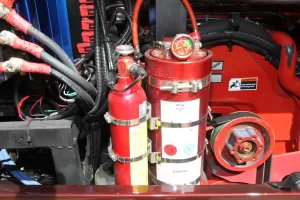
A Fogmaker automatic fire suppression system is shown in a Foretravel motorhome.
Engine compartments are a different matter. A larger automatic extinguisher is a good choice for that area, but clean agent gas isn’t always the best choice. Clean agent gas works by replacing the oxygen in the air. But engine compartments are not enclosed areas, and the gas is hard-pressed to fill that area effectively, especially if the engine is running and the radiator fan is moving air through that compartment. In that case, another choice is an automatic foam-type extinguisher using high expansion compressed air foam. The designer foam will coat the area and reduce the temperature to help control the fire.
One option for an automatic engine compartment extinguisher is the Fogmaker fire-suppression system. The Fogmaker uses a high-pressure water mist that claims to decrease temperatures by 700 degrees Celsius within 10 seconds to lower the temperature below that required for combustion. A small amount of foam additive prevents hydrocarbon vapors from reigniting. A sensor connects to a warning display on the cockpit instrument panel.
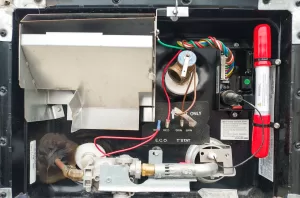
Proteng tubes filled with clean agent gas rupture when exposed to high heat.
Another type of extinguisher, born in automobile racing, is the THIA by Proteng system, which uses nontoxic FM-200 clean agent gas. The unique thing about the Proteng is that the gas is precharged in sealed polyamide tubes that can be placed in key locations. No sensors, wiring, hoses, or sprinkler heads are used. When the tube reaches the designated temperature, it ruptures and expels the clean agent gas to smother the fire. The tubes come in various sizes and are specified for each RV. They are a great choice for placement behind RV absorption refrigerators and near generator sets, electrical control panels, etc. The Proteng system is sold exclusively by National Indoor RV Centers. Systems run from approximately $159 to $1,399, but FMCA members receive up to 10 percent off; see www.fmca.com/proteng for details.
One major consideration with any fire is a reflash. A fire can restart after being extinguished. For instance, if a diesel-pusher motorhome develops a fuel or hydraulic oil leak that ignites a fire, an automatic extinguisher will deploy. However, odds are strong that you won’t have any indication of what’s happening 40 feet behind you. Once the extinguisher has emptied, the fuel or oil will still be pumping, and the fire will reignite.
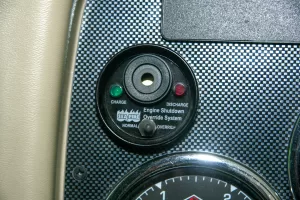
A dash-mounted alert system is an important accessory for automatic engine compartment extinguishers.
My personal opinion is that any automatic fire-suppression system needs to have a pressure switch and some sort of alarm system to be truly effective. By having a remote alarm that senses pressure loss in the extinguisher, you’ll receive an early warning of the fire. You’ll then be able to pull off the road and shut the engine down. In this case, the automatic extinguisher performs a holding action. You will then have enough time to analyze the fire and attack it with a handheld extinguisher if necessary. Professional alarms can be used, or something as simple as a 12-volt buzzer and flashing light on the dash works as well. An optional pressure switch does need to be mounted on the tank and can be added at a reasonable cost, but you need to specify this when ordering your system, because it’s not generally shown on the manufacturer’s website.
SMOKE ALARMS
An effective warning system can save your RV — or your life.
Smoke alarms utilize either ionization or photoelectric sensing technologies. An ionization-type smoke alarm places a small amount of radioactive material between two electrically charged plates, which then ionizes the air between the plates and allows a small electrical current to flow between them. Whenever smoke gets between these plates, it interrupts the flow of electricity and triggers the alarm. Ionization detectors are more responsive to flaming fires.
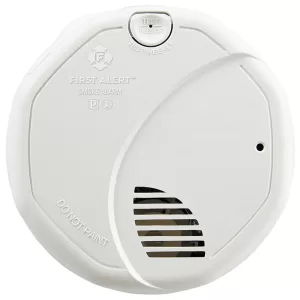
Dual-sensor smoke alarms such as the First Alert 3120B combine both ionization and photoelectric technology.
Photoelectric smoke alarms shoot a small beam of light at an angle to the sensor. Whenever smoke enters the chamber, it refracts the beam of light so that it lands on the sensor, triggering the alarm. Photoelectric alarms are more sensitive to smoldering fires. Each type works best in different situations. If your electrical wiring shorts and its insulation begins to smolder, a photoelectric alarm will give you an earlier warning before the wiring can ignite nearby materials into flame. You’ll have a better chance of shutting down that electrical circuit to prevent a full-blown fire with this kind of alarm.
However, for flash fires, a smoke alarm using ionization technology will alert you more quickly than a photoelectric sensor-based alarm will. Fortunately, manufacturers such as Kidde and First Alert make a dual-sensor smoke alarm that incorporates both types of sensors in one common unit.
Smoke rises, so smoke alarms need to be mounted on the ceiling or on a sidewall immediately next to the ceiling. In large RVs, it may take a while for smoke to travel from one end to the other. Therefore, it’s important to have multiple smoke alarms, locating one at each end of the RV and near sleeping spaces. Don’t place one right in the cooking area; you’ll receive plenty of false alerts and may get so annoyed that you wind up removing the battery, rendering it useless when you really need it.
OTHER ALARMS
If an RV develops a leak in a propane line or an appliance, highly flammable gas can build up. Propane is heavier than air, so it settles near the ground, where it can creep along waiting for a pilot light or spark to ignite it. That is why propane alarms are mountedon an interior wall close to the floor. They are also susceptible to aerosols, such as hair spray, or various cleaning agents. To avoid ruining the devices, do not use such products nearby. Propane alarms have a test button, which should be used to check them on a regular basis.
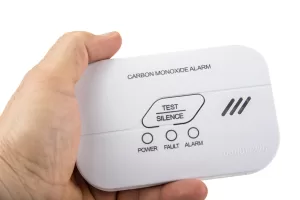
It is important to have a working carbon monoxide detector on board your RV.
Carbon monoxide (CO) is a byproduct of combustion and can come from fire, a furnace with a cracked heat exchanger, an exhaust system, or the exhaust from an auxiliary generator — yours or your neighbor’s. CO is slightly lighter than air and rises, but it doesn’t rise to the ceiling the way smoke does, so CO detectors usually should be mounted mid-wall. Check the manufacturer’s instructions for placement.
Many manufacturers now offer combination alarms, either a propane and CO alarm, or a smoke and CO alarm. The combination propane and CO alarms sometimes are located beneath the refrigerator, which is perfect for detecting propane, but may not be as effective for detecting carbon monoxide. Follow the manufacturer’s recommendations on the best location to place the alarm. Some CO alarms feature a digital LCD display that shows how much CO gas has accumulated. As little as 250 parts per million over an eight-hour period can be fatal, so a good alarm adds up the cumulative amounts, while less expensive models sound an alert only if a large amount of CO is present at one time.
PROPER PREPARATION
Without a doubt, the most important factor when dealing with a fire is a calm mind. In an emergency, the mind always reverts to preparation, so rehearse what to do under any given situation. Discuss and practice how to deal with a particular fire and whether to fight it or exit the RV. Practice each escape route and method so that you don’t have to figure it out at the last minute.
Outfit your RV with adequate fire extinguishers to cover your needs. Relying on the small dry chemical unit that came with the RV might not be enough. Even upgrading to a larger unit won’t help you if it’s located at the front door and the fire begins in the middle of your RV while you are sleeping in the bedroom. You’ll need multiple extinguishers in various locations. The same holds true for warning devices. Smoke, propane, and carbon monoxide alarms need to be properly located in order to be effective. Again, check the manufacturer’s instructions regarding placement. Also verify that the device is suitable for use in an RV.
Knowledge is power. Attend a fire and safety seminar at an FMCA international convention. Attending one of these free seminars is the best investment of time you can make. You’ll gain immeasurable knowledge to help keep you safe in your RV travels.
FIRE CLASSIFICATIONS
CLASS A FIRES
- Ordinary Combustibles
- Consist of wood, paper, cloth, trash, and plastics. Class A fires leave ash, so think of the word “Ash” to help remember the characteristics of this type of fire.
CLASS B FIRES
- Flammable Liquids
- Originate from flammable liquids such as gasoline, oil, grease, diesel fuel, and alcohol. Liquids boil, so think of the word “Boil” to remember what Class B fires are.
CLASS C FIRES
- Live Electrical Equipment
- Electrical fires caused by energized circuits. Electrical wires conduct current, so associate the word “Current” with a Class C fire.
KNOW YOUR FIRE EXTINGUISHER CODES
Class A extinguishers are used on fires involving ordinary combustibles such as wood, paper, and cloth.
Class B extinguishers are used on fires containing flammable liquids, greases, and gases.
Class C extinguishers are used on fires involving energized electrical equipment.
SOURCES & REFERENCES
First Alert
(800) 323-9005
www.firstalert.com
Fogmaker North America
(610) 265-3610
www.usscgroup.com/fogmaker-fire-suppression/
Kidde
(800) 880-6788
www.kidde.com
Proteng (NIRVC)
(800) 210-0692
proteng.com
www.fmca.com/proteng
The post RV Fire Safety appeared first on Family RVing Magazine.
Source: https://familyrvingmag.com/2023/12/01/rv-fire-safety-5/


